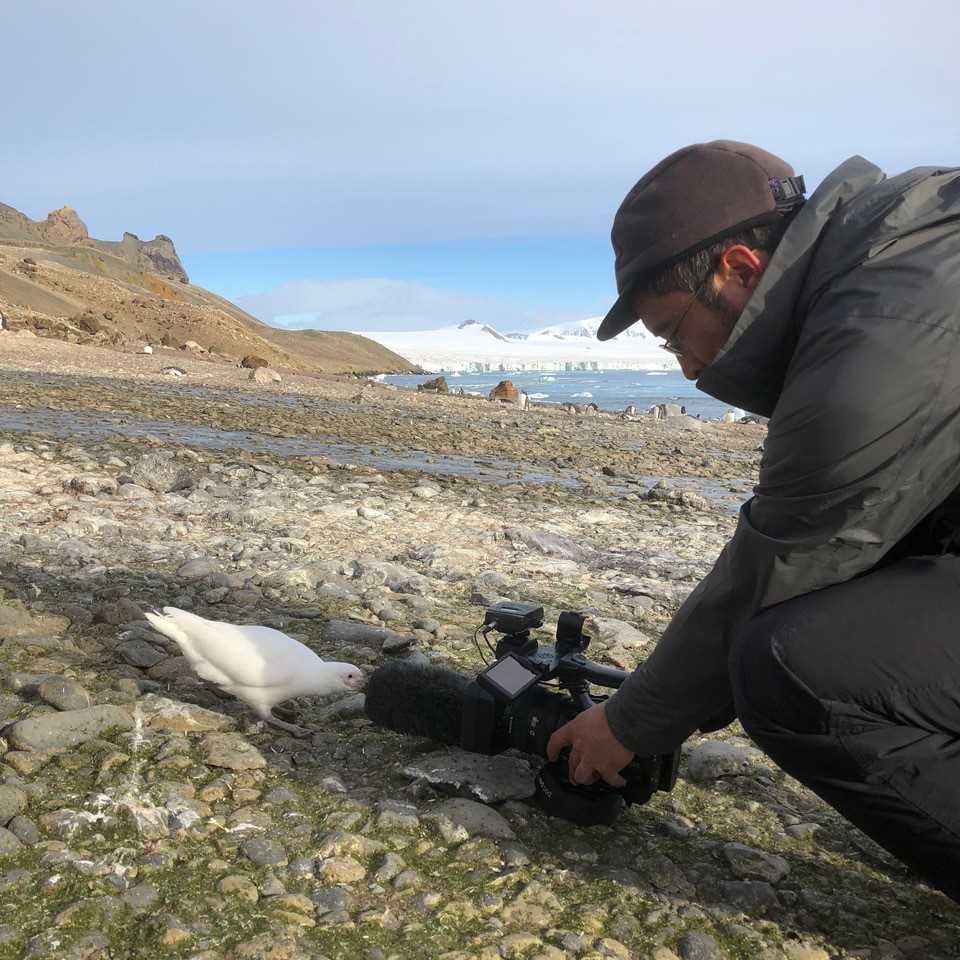For some our morning started at 5 a.m. when we came to the bridge, dressed for brisk weather, to watch our approach to Antarctic Sound at sunrise. We’d had a beautiful sunset the evening before while sailing in the Orléans Strait. As we watched the sun set, a half-moon rose. What surprised everyone was that it was rising less than 90º from where the sun had set, rather than the 180º everyone was used to. We are indeed far south.
We wondered aloud if the sunset were so wonderful, what would sunrise reveal? A cloud stretching across the morning sky caught the early light, turning first pink and then a brilliant orange as the sun rose over a low fog bank. We started seeing massive freshwater tabular icebergs with steep sides and flat tops—so starkly cubist in form they would have made Picasso or Braque jealous. Tabular icebergs are created when they calve off of an ice shelf rather than a glacier. They are floating ice islands. If they remain in Antarctic waters they can drift about for decades.
Our skilled and highly professional bridge team carefully maneuvered National Geographic Orion past the icebergs, bergy bits, and growlers that congregate here in the relatively narrow 30-mile long Antarctic Sound, a stretch of water between the Joinville Island group and the tip of the Antarctic Peninsula. We were treated to a wonderful display of shimmering, floating ice as the warmth of the sun burnt off the fog.
Our morning destination was nine miles south of Hope Bay on the east side of the Tabarin Peninsula at the northeast end of the Antarctic Peninsula. Brown Bluff is an ice-capped flat-topped mountain 745 meters at its highest point. In a landscape otherwise surrounded by sinuous fields of snow and ice, the Falkland Islands Dependencies Survey gave the place its name in 1946 because of the prominent reddish brown volcanic rock on the north face. It is pillow lava, formed during a sub-glacial lava flow. Scientists can gauge the thickness of the ice cap at the time of eruption by the look of the tuya formation. A similar tuya volcanic formation is found in the Badlands of South Dakota.
Growlers and bergy bits, pushed by the wind, littered the pebble beach where we landed. Near the landing were several beautiful ventifacts (or ventiliths), rocks with a distinct curved surface formed by a constant blasting of sand and debris carried by brisk winds off the cold sea. Historically known for 20,000 pairs of Adélie penguins that breed here each season, it now features both gentoo and Adélie brush-tailed penguins. We could see where the gentoo penguin nests had been, delineated with nearly perfect concentric circles of penguin guano. Most of the Adélies, who nested higher on the beach and on the scree slope, had swum away, their breeding season at an end, with only a few left, and most of them would be gone within the week. Many of the gentoos were molting so we gave them a wide berth so they wouldn’t use up any unnecessary energy avoiding us as they are on a forced fast until they can re-enter the sea to fish again. Their chubby chicks waddled around, not yet ready to enter the sea either. With at least four leopard seals lying about on icebergs or in the water, it was easy to see why we didn’t see many penguins in the water among those that could swim in the Southern Ocean.
There were at least seven fur seals sunning themselves and trying to sleep after a night of hunting and eating. Besides the penguins we saw pintados (cape petrels) with their distinctive piebald markings as if an artist had flicked a brush of white paint on a black bird. Imagine a bird drip painted by Jackson Pollock and you have a pintado. They had their nests tucked into the cliffside. Snowy sheathbills, their plumage as white as their name suggests, came right up to us on the beach. One was particularly intrigued when Mark Coger, our video chronicler, put his camera at ground level. It could see itself reflected in the lens and came right up to investigate. There was some kelp along the seashore and we saw kelp gulls, the only gull in the Antarctic. Omnipresent were the fearless and piratical skuas, always looking for a meal. We also found desiccated remains of gentoo penguins, their bodies neatly mummified by the dry cold air. We could see how their knees were inside their bodies, why they walk with such a waddle. Imagine if your pants dropped to your knees how graceful your walk would be.
When we returned we were treated to grilled sausages and hot dogs served on the aft deck along with cold beer and Bloody Marys. A pair of humpback whales swam leisurely alongside the ship as we slowly maneuvered through a maze of icebergs, the blue of the ice mimicked in little patches of blue in the dark, cloudy sky.
We left Antarctic Sound and sailed into the Weddell Sea, the great ice-filled sea that indents the Antarctic Continent between the Antarctic Peninsula and Cape Norvegia, Queen Maud Land. It is named after Master James Weddell who discovered it in 1823. We were headed toward Paulet Island in the Erebus and Terror Gulf, named for HMS Erebus and HMS Terror, the ships Sir James Clark Ross used to explore this area in 1842-1843.
We all witnessed Captain Martin Graser and his bridge team carefully maneuver us through a big patch of broken pack ice and icebergs pushed together by wind, using the ships bow thrusters to make ballet like moves to slide past. We, on the other hand, could photograph these icebergs at close range, beautiful in their gradations and striations of color, from white to deep blues so radiant they seemed to glow from within.
Paulet Island, situated three miles southeast of ice-covered Dundee Island, is a circular volcanic island of black and reddish colored rocks with a large colony of 100,000 pairs of Adélie penguins that were busy manufacturing tons of guano that all of us spent a lot of time washing off of our boots, clothing, and walking poles when we got back to the cleaning station on our ship. A particularly odoriferous endeavor.
Paulet Island also entailed landing on a pebble beach lined with growlers and bergy bits, pushed tight by the wind. Near the landing, up on a rocky bench, were the remains of the rock walls of the winter camp of the Swedish Antarctic Expedition. It was nominally under the command of Dr. Otto Nordenskjöld but he’d already been dropped off on another island for the winter and didn’t know his ship Antarctic, under the command of Captain C. A. Larsen, had been trapped and then crushed by ice. Larsen, a noted Norwegian Antarctic explorer, spent the winter of 1902 with his 20 men and one cat here in this hut. It would have been snug. They killed 1100 penguins as soon as they arrived on Paulet Island to provide them with something to eat. Everyone survived, including the cat, except for one man who died of heart disease. The following spring they were rescued, including Nordenskjöld, who didn’t know that the Antarctic had sunk and Captain Larsen wouldn’t be sailing back to pick him up.
Most of us hiked to a freshwater lake, soiled by guano, which lay in a basin behind the hut. Some hiked up to a saddle to see what was on the other side (more Adélie penguins, guano, a lake and a different view of the Erebus and Terror Gulf and seashore).
Unlike Captain Larsen and his men, once our day’s adventures were over, we could retire to the ship’s lounge for cocktails, appetizers, and our nightly recap with presentations by the knowledgeable and talented staff of naturalists, undersea specialists, historians and professional photographers, and then look forward to a delicious meal in the ship’s restaurant prepared by Chef Lothar. This evening he and his exceptional team were proud to present for tonight’s degustation Antarctica “Ice Blue” Dinner that included such favorites as “Blended Skua Droppings” (sweet pea soup with fresh mint and truffle oil), “A Morsel for an Albatross” (Samosa of Beagle Channel centolla king crab, tomato-red onion and coriander raita with fresh mint yoghurt), “Penguin’s Choice (North Atlantic halibut fillet, wild mushroom risotto, lobster claw, spinach, herb oil, balsamic reduction, sweet pepper essence), “A Leopard Seal’s Favourite” (slow roasted veal tenderloin, crushed potatoes with virgin olive oil, beetroot puree, carrot puree, broccoli, pommery mustard sauce), followed by “Albatross’s curdled Egg Custard” (crème brulee with fruit ratatouille) and “Smells like a Whole Rookery” (Chef’s selection of British and French cheeses). There was a different wine selected for each dish. It was a culinary treat made all the more remarkable as we sailed in the Weddell Sea, a continent away from any store or source of provisions.







